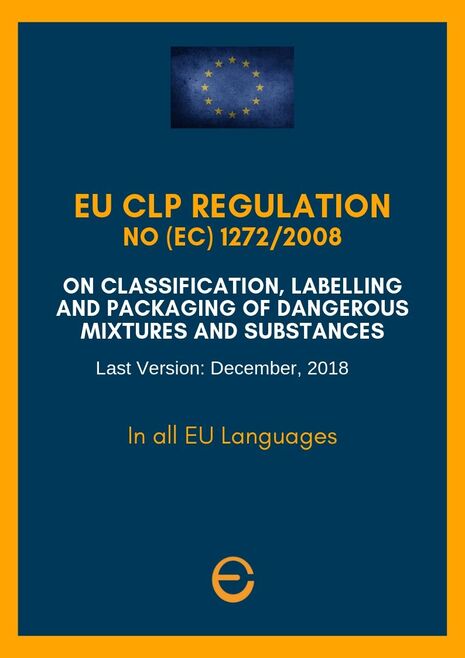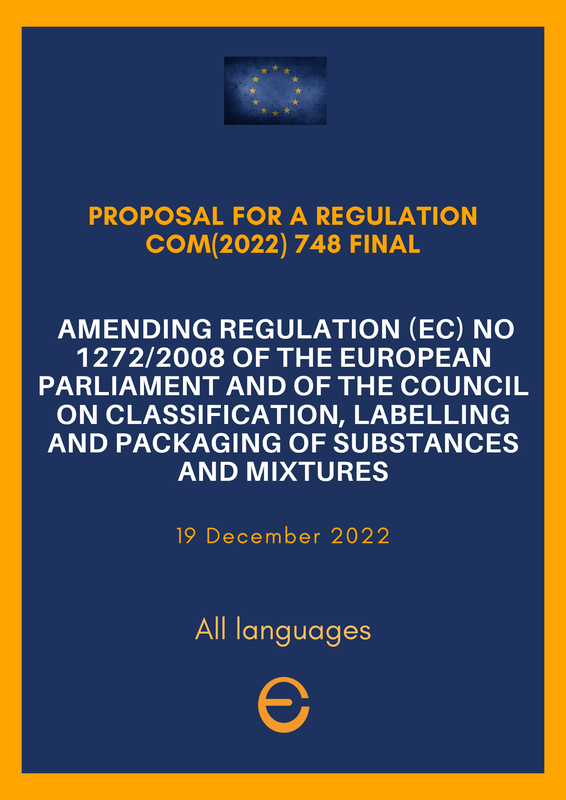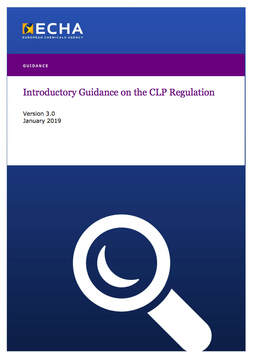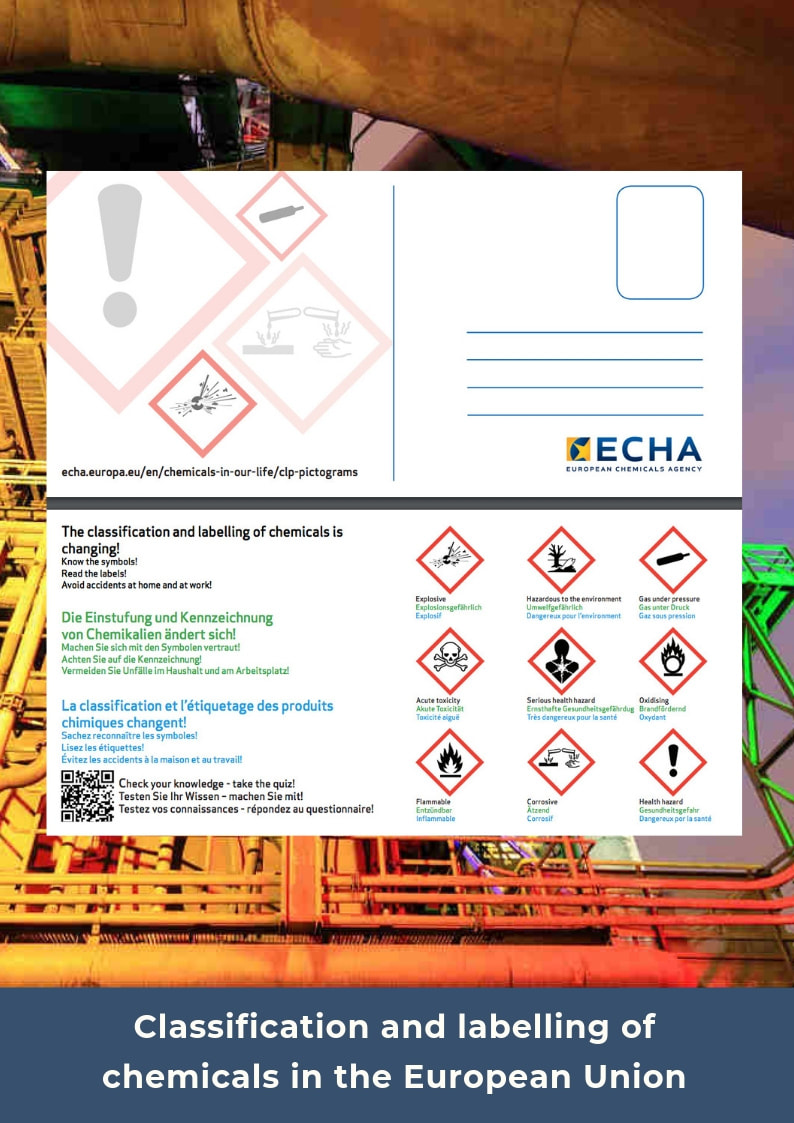CLP - Classification, Labelling and Packaging of dangerous mixtures and substances
|
The EU has decided common rules on classification, labelling and packaging of substances and chemical mixtures (the 'CLP Regulation').
Here the coordinated text: Regulation (EC) No 1272/2008. These rules implement the United Nations' Globally Harmonised System of Classification and Labelling of Chemicals (GHS), which provides a harmonised basis for globally uniform physical, environmental, and health and safety information on hazardous chemical substances and mixtures. Info
|
- It replaces the former rules on classification, labelling and packaging of substances (Directive 67/548/EEC). The date from which substance classification and labelling must be consistent with these rules is 1 December 2010 and for mixtures 1 June 2015.
- The old Directives on classification, labelling and packaging, i.e. Council Directive 67/548/EEC and Directive 1999/45/EC, were repealed on 1 June 2015. Mixtures placed on the market before 1 June 2015 in compliance with Directive 1999/45/EC were sold with the old label until 1 June 2017.
- Together with the compromise package for the CLP Regulation, the EP and the Council adopted two related acts which adapt further EU acts to the new rules on classification and labelling, Directive 2008/112/EC, OJ L 345
- The Institute for Health and Consumer Protection (IHCP; Ex-ECB) has made available the Table 3.1 and 3.2 of Annex VI in excel format for downloading.
Revision of the CLP Regulation
|
On 19 December 2022, the European Commission drafted a Proposal for a revision of the current Regulation. This revision brings the chemicals sector into the digital and circular economy age, ensuring consumers have access to necessary information regardless of the purchasing method.
On 5 December 2023, the Council and the European Parliament reached a provisional agreement on the revised regulation. Key Highlights of the Agreement:
|
- Improved Communication and Processes: Simplified labelling and advertising requirements, including online communication of chemical hazards, are introduced. This includes measures such as a minimal font size for chemical labels.
- New Powers and Specific Rules: The Commission, alongside member states and industry, is empowered to quickly identify hazardous substances and propose classifications. The agreement also sets specific rules for refillable chemical products to ensure safe consumer usage.
- Derogation for Certain Substances: A 5-year derogation is included for multi-constituent substances (MOCS) derived from unmodified plant parts, with future legislation potentially based on scientific reports.
- Digital and Circular Economy in Chemicals Sector: As highlighted by Jordi Hereu i Boher, Spanish Minister for Industry and Tourism, this revision brings the chemicals sector into the digital and circular economy age, ensuring consumers have access to necessary information regardless of the purchasing method.
- Safety Measures for Refill Stations: The agreement also aims to mitigate risks associated with refill stations, such as overfilling and contamination.
How CLP works
|
1. Hazard identification and classification Hazard identification is the process by which information about the intrinsic properties of a substance or mixture is assessed to determine its potential to cause harm. If the nature and severity of an identified hazard meets the classification criteria in Annex I to the CLP Regulation, a certain hazard class will be assigned to the substance or mixture. There are hazard classes for physical hazards, health hazards, and environmental hazards. For most substances and mixtures, manufacturers, importers, downstream users and distributors must determine the hazard classification themselves. In certain cases, the classification of a chemical is harmonised at EU level. The list of harmonised classification and labelling is included in Annex VI to the CLP Regulation. Please consult the ECHA website for a full guidance. |
|
2. Labelling
Once the substance or mixture is classified based on its hazards, the hazards needs to be communicated to the user. The label of a hazardous substance or mixture includes pictograms, signal words, hazard statements, precautionary statements, and supplemental statements. Under the CLP Regulation, pictograms with a red diamond on a white background replace the orange squares from the old system. For more information on the labelling of hazardous substances and mixtures, including guidance documents, please consult the ECHA website. 3. Packaging
CLP sets general packaging standards to ensure the safe supply of hazardous substances and mixtures. In the case of certain hazards, substances and mixtures need to carry child-resistant fastenings and/or tactile warnings. |
Classification and Labelling rules for international transport purposes are developed under the United Nations Recommendations on the Transport of Dangerous Goods with close links to the UN GHS. For more on classification and labelling for transport, see the website of DG MOVE.
Poison centres
The CLP Regulation requires EU countries to appoint bodies 'responsible for receiving information on dangerous mixtures in order to formulate appropriate emergency measures (so called poison centres)’.
National helpdesks have been established to provide guidance in national languages. Their contact details are available from the helpdesk section of the ECHA website.
The CLP Regulation requires EU countries to appoint bodies 'responsible for receiving information on dangerous mixtures in order to formulate appropriate emergency measures (so called poison centres)’.
- Go to poison centres page
- Read more on the role of CLP key players
National helpdesks have been established to provide guidance in national languages. Their contact details are available from the helpdesk section of the ECHA website.





